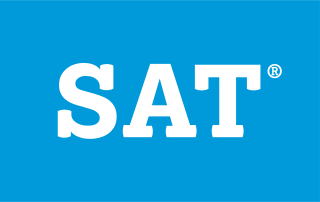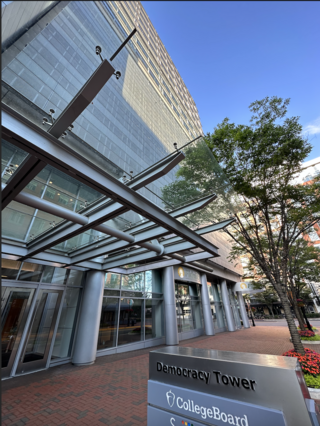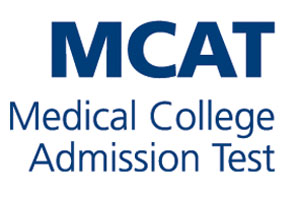
The ACT is a standardized test used for college admissions in the United States. It is administered by ACT, a nonprofit organization of the same name. The ACT test covers four academic skill areas: English, mathematics, reading, and scientific reasoning. It also offers an optional direct writing test. It is accepted by all four-year colleges and universities in the United States as well as more than 225 universities outside of the U.S.

The SAT is a standardized test widely used for college admissions in the United States. Since its debut in 1926, its name and scoring have changed several times. For much of its history, it was called the Scholastic Aptitude Test and had two components, Verbal and Mathematical, each of which was scored on a range from 200 to 800. Later it was called the Scholastic Assessment Test, then the SAT I: Reasoning Test, then the SAT Reasoning Test, then simply the SAT.

A pharmacist, also known as a chemist in Commonwealth English, is a healthcare professional who specializes in the preparation, dispensing, and management of medications. A pharmacist provides pharmaceutical advice and guidance, often serving as a primary care provider in the community, and offering other services, such as health screenings and immunizations.

The General Educational Development (GED) tests are a group of four academic subject tests in the United States and Canada certifying academic knowledge equivalent for a high school diploma. This certification is an alternative to the U.S. high school diploma, as is HiSET. Passing the GED test gives those who do not complete high school, or who do not meet requirements for high school diploma, the opportunity to earn a Certificate of High School Equivalency or similarly titled credential. GED Testing Service is a joint venture of the American Council on Education, which started the GED program in 1942.

Advanced Placement (AP) is a program in the United States and Canada created by the College Board. AP offers undergraduate university-level curricula and examinations to high school students. Colleges and universities in the US and elsewhere may grant placement and course credit to students who obtain qualifying scores on the examinations.

The Graduate Record Examinations (GRE) is a standardized test that is part of the admissions process for many graduate schools in the United States and Canada and a few other countries. The GRE is owned and administered by Educational Testing Service (ETS). The test was established in 1936 by the Carnegie Foundation for the Advancement of Teaching.

The College Board, styled as CollegeBoard, is an American not-for-profit organization that was formed in December 1899 as the College Entrance Examination Board (CEEB) to expand access to higher education. While the College Board is not an association of colleges, it runs a membership association of institutions, including over 6,000 schools, colleges, universities, and other educational organizations.
The North American Pharmacist Licensure Examination (NAPLEX) is a standard examination created by the National Association of Boards of Pharmacy (NABP) to help individual state boards of pharmacy assess an individual's competency and knowledge so that they may be given a license to practice. The NABP has announced that as of November 2016, the fee to take the exam, the number of exam questions, and the time to sit for the exam have all increased.
The Graduate Medical School Admissions Test is a test used to select candidates applying to study medicine, dentistry, optometry, pharmacy and veterinary science at Australian, British, and Irish universities for admission to their Graduate Entry Programmes. Candidates may take the test in a test centre in one of the 6 countries, being Australia, Ireland, New Zealand, Singapore, the United Kingdom and the United States, offering the test.
The Specialized High Schools Admissions Test (SHSAT) is an examination administered to eighth and ninth-grade students residing in New York City and used to determine admission to eight of the city's nine Specialized High Schools. An average of 25,000 students take the test to apply to these schools, and around 5,000 are accepted. The test is given each year in October and November, and students are informed of their results the following March. Those who receive offers decide by the middle of March whether to attend the school the following September. The test is independently produced and graded by American Guidance Service, a subsidiary of Pearson Education, under contract to the New York City Department of Education.
West Bengal Joint Entrance Examination (WBJEE) is a state-government controlled centralized test, conducted by the West Bengal Joint Entrance Examinations Board for admission into Undergraduate Courses in Engineering/Technology, Pharmacy and Architecture of different Universities, Government Colleges as well as Self Financing, Private Institutes in the State of West Bengal.

Liberal arts colleges in the United States are undergraduate institutions of higher education in the United States that focus on a liberal arts education. The Encyclopædia Britannica Concise defines liberal arts as a "college or university curriculum aimed at imparting general knowledge and developing general intellectual capacities, in contrast to a professional, vocational, or technical curriculum". Generally, a full-time, four-year course of study at a liberal arts college leads students to earning the Bachelor of Arts or the Bachelor of Science.
College of Pharmacy is part of the University of Arizona, a public university in Tucson, Arizona, United States. It is the only pharmacy school at a public Arizona university and one of four health professions colleges at the Arizona Health Sciences Center campus. The college is accredited by the Accreditation Council for Pharmacy Education.
The basic requirement for pharmacists to be considered for registration is often an undergraduate or postgraduate pharmacy degree from a recognized university. In many countries, this involves a four- or five-year course to attain a bachelor of pharmacy or master of pharmacy degree.
The California Basic Educational Skills Test (CBEST) is a standardized test administered in the state of California. It is available as an option in Oregon and Nevada. The test is intended to score basic proficiency in reading, mathematics, and writing. The test is divided into three sections: the reading and math sections each containing 50 multiple-choice questions; and the writing section, consisting of two essay questions. The entire test must be completed in four hours, and test-takers may allocate the time to each section at their discretion. There is no limit to the number of times the test may be taken. Test-takers do not have to pass all three sections in one sitting. A $41 registration fee for paper-based testing must be paid each time the test is taken.

Birla Institute of Technology & Science, Pilani is a deemed university in Pilani, Rajasthan, India. It focuses primarily on higher education and research in engineering and sciences. BITS Pilani is one of the first six institutes in India to be granted Institute of Eminence status. According to 2012 data, BITS Pilani has an acceptance rate of 1.47%, making it one of the most exclusive technical universities in the world.

The Medical College Admission Test is a computer-based standardized examination for prospective medical students in the United States, Australia, Canada, and the Caribbean Islands. It is designed to assess problem solving, critical thinking, written analysis and knowledge of scientific concepts and principles. Before 2007, the exam was a paper-and-pencil test; since 2007, all administrations of the exam have been computer-based.
Hocutt v. Wilson, N.C. Super. Ct. (1933) (unreported), was the first attempt to desegregate higher education in the United States. It was initiated by two African American lawyers from Durham, North Carolina, Conrad O. Pearson and Cecil McCoy, with the support of the National Association for the Advancement of Colored People (NAACP). The case was ultimately dismissed for lack of standing, but it served as a test case for challenging the "separate but equal" doctrine in education and was a precursor to Brown v. Board of Education, 347 U.S. 483 (1954).










